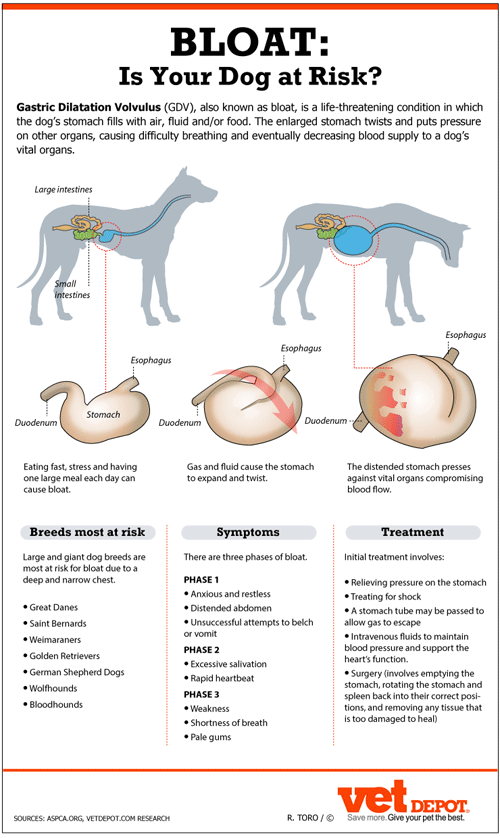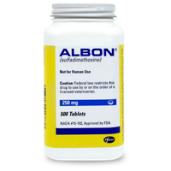Gastric Dilatation and Volvulus (GDV) or “bloat” is an emergency situation that may be difficult for dog-owners to recognize. Dogs are in severe pain while suffering from bloat, and without prompt and aggressive treatment, the condition is usually fatal.
Who is Most at Risk?
Large and giant dog breeds, such as Great Danes, Saint Bernards, Weimaraners, Golden Retrievers, German Shepherd Dogs, Wolfhounds and Bloodhounds, are most at risk for bloat due to a deep and narrow chest. The incidence increases with age. Additionally, there is a familial association with this condition (it tends to run in families), and it is likely to happen again in the same pet if definitive treatment (surgery) is not performed.

Ingestion of a large amount of food or air is also a risk factor for bloat. This might result from:
- eating fast
- eating from an elevated food bowl
- eating one large meal each day
- stress (from pain or anxiety) that causes panting
Dry food eaters and those without access to adequate water seem to be most at risk. Exercise after eating has long been accused of causing bloat, but clinical studies do not support this.
Preventing Bloat
Owners have many tools available to help reduce the chances that their dogs will develop bloat:
- Feed several small meals each day
- Do not feed from an elevated food bowl
- Offer water at all times
- Do not breed dogs with a history of bloat or their direct family members
- Try to reduce stress especially around feeding time
- Consider having a “gastropexy” performed as a preventive measure
What is Bloat and Why is It So Serious?
Recent research has implicated two anatomical differences in dogs at risk for bloat that may contribute to the syndrome:
- loose stomach ligaments that allow for stretching of the stomach with gas and/or food
- delayed emptying of the stomach allowing for more pressure to build
Once the stomach is distended and ligaments are stretched, the stomach can rotate and flip over, which prevents food and gas from escaping. Because the spleen is attached to the stomach by ligaments, it too can rotate and flip over, compromising its own blood flow.
The distended stomach presses on the caudal vena cava (one of the main veins that return blood to the heart). This can lead to reduced cardiac output, arrhythmias, shock, and ultimately death. Pressure on the diaphragm can restrict lung expansion and severely impair the ability to breathe. Increased pressure on the lining of the stomach can lead to sloughing of the tissue and ulceration with life-threatening infections as a result.
Symptoms of Bloat
Dogs suffering from bloat will usually attempt to vomit, but are unable to bring anything up. They are nauseous and salivate excessively. They have a very distended, painful abdomen and are extremely restless. Their heartbeat may be irregular. As the disease progresses, blood pressure will drop, shock will develop, abnormal blood clotting may occur, and death is imminent without treatment.
"Dogs are in severe pain while suffering from bloat, and without prompt and aggressive treatment, the condition is usually fatal."
Diagnosing and Treating Bloat in Dogs
Diagnosis is fairly straightforward: breed, history, symptoms, and physical exam findings often lead to a tentative diagnosis of bloat. An abdominal x-ray can confirm the diagnosis, but the patient should be stabilized before time is taken to obtain an x-ray. This usually involves relieving pressure from within the stomach and intravenous fluid therapy.
Initial treatment involves relieving pressure on the stomach and treating for shock. A stomach tube may be passed to allow gas to escape; however, in many cases the stomach is twisted and a tube cannot be passed. If this is the case, a large bore needle is placed directly into the stomach through the dog’s abdominal wall. After the stomach is partially decompressed, a stomach tube can be passed to relieve more pressure.
Intravenous fluids are administered through at least one catheter in a leg to maintain blood pressure and support the heart’s function. Once the dog is stable, the veterinarian will take an abdominal x-ray if it he or she hasn’t done so already, run blood work and an electrocardiogram (ECG) to evaluate the dog’s overall condition, determine appropriate supportive care, and prepare for surgery.
Surgery involves emptying the stomach, rotating the stomach and spleen back into their correct positions, and removing any tissue that is too damaged to heal. If any portion of the stomach has undergone necrosis (cell death due to lack of blood supply), this area must be removed or it could slough, leading to a life-threatening infection. If the spleen has evidence of necrosis (or lost blood supply), it is usually removed, a procedure known as a “splenectomy”.
The surgeon should also perform a “gastropexy” during which the stomach is sutured to the right abdominal wall. A permanent adhesion should form, preventing future episodes of bloat. It will not prevent gas distention, but it will prevent the rotation of the stomach.
Post-Operative Complications

There are many complications that can occur at the time of surgery or shortly thereafter. Arrhythmias can occur during any anesthetic procedure, but are especially common with bloat due poor oxygen delivery to cardiac muscle and other factors that allow superoxide radicals (toxins) to be released into the blood supply. Additionally, arrhythmias occur in approximately 20-25% of splenectomies regardless of the underlying disorder.
Regurgitation and aspiration pneumonia (stomach material entering the lungs) can also occur due to the esophagus being distended. Special precautions during and after surgery must be taken to reduce this risk. Infections are also relatively common after bloat surgery. They can come from ulceration of the digestive tract or contamination during the procedure. Antibiotics are often administered to prevent and/or treat infections.
Other life-threatening complications are also possible. The veterinarian should discuss the pet’s prognosis with the owner at the onset of treatment.
Prognosis
Plasma lactate (a blood test) can be used as an indicator of prognosis. Traditionally, high levels (above 6.0 mmol/L) have been associated with increased mortality. However, a 2011 study disputes the value of this measurement. The study goes on to show that a decrease in plasma lactate concentrations = 50% within 12 hours may be a good indicator for survival. It is, therefore, prudent to measure lactate levels at the onset of treatment and continue to monitor these levels to keep owners informed of the prognosis as treatment continues.
Overall mortality rates have been reported from 15-30% of affected animals. Those dogs requiring removal of portions of the stomach have higher mortality rates. If dogs are treated within six hours after the onset of symptoms, they have a much greater chance of surviving. Therefore, owners should veterinary care as soon as possible when a dog develops symptoms consistent with bloat.
Sources
Birchard, S.J. (2011). Gastric Dilatation/Volvulus in the Dog. Presented at the Atlantic Coast Veterinary Conference, Atlantic City, N.J.
Green T.I., Tonazzi C.C., Kirby R., and Rudloff E. (2011) Evaluation of initial plasma lactate values as a predictor of gastric necrosis and initial and subsequent plasma lactate values as a predictor of survival in dogs with gastric dilatation-volvulus: 84 dogs (2003-2007). J Vet Emerg Crit Care 21:36-44
Beck et al. (2006). Risk factors associated with short-term outcome and development of peri-operative complications in dogs undergoing surgery because of gastric dilatation-volvulus: 166 cases (1992-2003). J Am Vet Med Assoc. 229(12):1934-9.
The above is provided for information purposes only and should not be used for the diagnosis or treatment of any condition.
This information does not cover all possible variables, conditions, reactions, or risks relating to any topic, medication, or product and should not
be considered complete. Certain products or medications may have risks and you should always consult your local veterinarian concerning the treatment of
your pet. Any trademarks are the property of their respective owners.